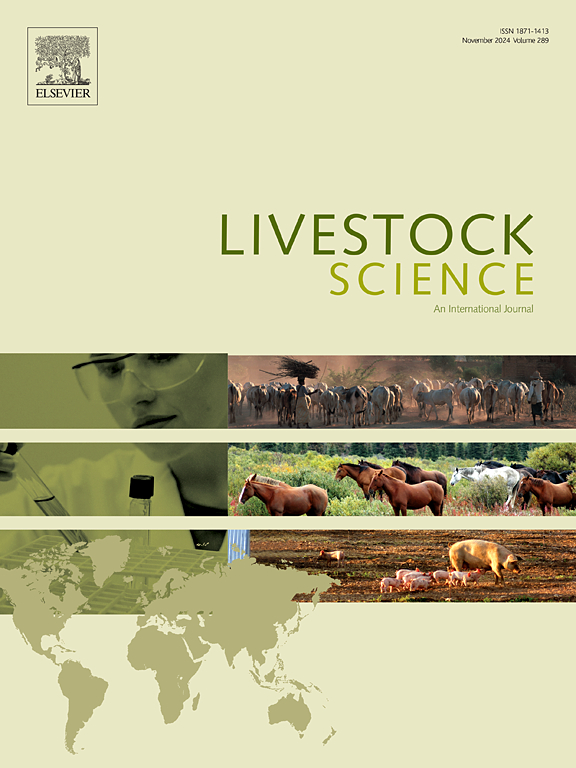The impact of post-weaning feeding strategies on feed consumption and body weight variation in pigs
IF 1.9
3区 农林科学
Q2 AGRICULTURE, DAIRY & ANIMAL SCIENCE
引用次数: 0
Abstract
At weaning, piglets experience stress due to various changes. Adequate post-weaning feed intake is crucial for optimal growth. Pre-starter feed may facilitate this transition. Feeding strategies were used to test the following hypotheses: 1) use of the same type of feed bowl for pre-starter feed in both farrowing pen and nursery enhances piglet performance; 2) liquid pre-starter provided post-weaning positively impacts piglet performance; and 3) these feeding strategies may have long-lasting effects on performance and carcass quality.
In two experiments, all piglets received pre-starter feed in a bowl in the farrowing pen. After weaning, piglets from one litter were split over two treatments.
In Experiment 1 (120 piglets, 26 pens), piglets received either 1) ad libitum weaning feed in a standard nursery feeder plus ad libitum pre-starter in the familiar farrowing bowl during the first week after weaning (two-feeder) or 2) ad libitum weaning feed after a fixed volume of pre-starter in a standard nursery feeder (one-feeder). One-feeder piglets therefore had to consume all pre-starter before accessing the weaning feed, while two-feeder piglets could choose between feeds at the same time. Two-feeder piglets consumed less pre-starter (77 vs. 125 g/d) but more weaning feed (188 vs. 68 g/d) and total feed (266 vs. 193 g/d) during the first week post-weaning. However, their gain-to-feed ratio was lower (0.47 vs. 0.60 kg/kg). In the following week, the two-feeder group showed slower weight gain (209 vs. 239 g/d) and tended to consume less feed (302 vs. 346 g/d/piglet) compared to the one-feeder group.
In Experiment 2 (164 piglets, 32 pens), during the first week post-weaning all piglets received pre-starter in the same type of bowl as in the farrowing pen, either as dry feed or liquid feed, with weaning feed presented to all piglets in the standard nursery feeder. Pens with liquid pre-starter consumed more pre-starter (64 vs. 26 g/d) and total feed (170 vs. 134 g/d) and showed lower weight variation (15.7 vs. 18.4 %) during the first week post-weaning. However, a lower gain-to-feed ratio (0.88 vs. 0.90 kg/kg) was observed for pens with liquid pre-starter over the first five weeks post-weaning. Furthermore, the average daily gain (370 vs. 317 g/d) during the second week post-weaning was higher with liquid pre-starter.
In summary, both feeding strategies impact post-weaning performance. Liquid pre-starter increased feed intake, body weight uniformity and growth performance short term, but reduced feed efficiency. Despite short term effects post-weaning, no significant long term effects on performance were observed.
断奶后饲喂策略对猪饲料消耗和体重变化的影响
断奶时,仔猪会因各种变化而产生应激。断奶后充足的采食量对于实现最佳生长至关重要。断奶前饲料可促进这一过渡。我们采用了饲喂策略来验证以下假设:1) 在产仔栏和保育舍中使用相同类型的饲料碗饲喂开产前饲料可提高仔猪的生产性能;2) 断奶后提供液体开产前饲料对仔猪的生产性能有积极影响;3) 这些饲喂策略可能对生产性能和胴体质量有长期影响。在两项实验中,所有仔猪都在产仔栏中用饲料碗饲喂开产前饲料。在实验 1 中(120 头仔猪,26 个猪栏),仔猪在断奶后的第一周在标准保育舍饲喂器中自由采食断奶料,并在熟悉的产仔碗中自由采食开食料(两头饲喂),或在标准保育舍饲喂器中采食固定量的开食料后自由采食断奶料(一头饲喂)。因此,单食槽仔猪必须在吃完所有预开食料后才能吃断奶料,而双食槽仔猪则可以同时选择不同的饲料。在断奶后的第一周,双料仔猪消耗的开食料较少(77 克/天对 125 克/天),但断奶料(188 克/天对 68 克/天)和总饲料(266 克/天对 193 克/天)却较多。但是,它们的料增比却较低(0.47 vs. 0.60 kg/kg)。在实验 2(164 头仔猪,32 个猪栏)中,在断奶后的第一周,所有仔猪都在产房猪栏中使用相同类型的碗,以干料或液态料的形式接受预开食料。使用液体预混料的猪栏消耗更多的预混料(64 克/天对 26 克/天)和总饲料(170 克/天对 134 克/天),断奶后第一周的体重变化较小(15.7% 对 18.4%)。然而,在断奶后的前五周,观察到使用液体预开食器的猪栏的增重-饲料比(0.88 vs. 0.90 kg/kg)较低。总之,两种饲喂策略都会影响断奶后的生产性能。总之,这两种饲喂策略都会影响断奶后的生产性能。液体预混料可在短期内提高采食量、体重均匀度和生长性能,但会降低饲料效率。尽管断奶后会产生短期影响,但没有观察到对生长性能有显著的长期影响。
本文章由计算机程序翻译,如有差异,请以英文原文为准。
求助全文
约1分钟内获得全文
求助全文
来源期刊

Livestock Science
农林科学-奶制品与动物科学
CiteScore
4.30
自引率
5.60%
发文量
237
审稿时长
3 months
期刊介绍:
Livestock Science promotes the sound development of the livestock sector by publishing original, peer-reviewed research and review articles covering all aspects of this broad field. The journal welcomes submissions on the avant-garde areas of animal genetics, breeding, growth, reproduction, nutrition, physiology, and behaviour in addition to genetic resources, welfare, ethics, health, management and production systems. The high-quality content of this journal reflects the truly international nature of this broad area of research.
 求助内容:
求助内容: 应助结果提醒方式:
应助结果提醒方式:


